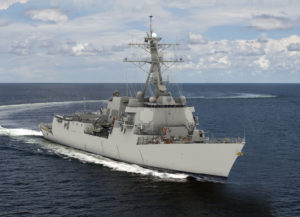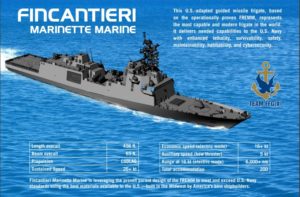The Program Executive Officer (PEO) for Ships this weeksaid the Navy is working to mature new technology and use land-based test sites while trying to make only reasonable risks in new ship classes.
PEO Ships Rear Adm. Tom Anderson has been in the position for about three months and noted “there’s been quite a bit of discussion about future programs and what are – I’ll say credible timelines to develop a new program and get into production and deliver it.”

He underscored that from the ship buyer’s perspective, his top considerations are capacity and capability of the industrial base.
“It’s at the top of the list. What do we have today, what do we need for tomorrow and then how do we efficiently and effectively transition between the two. It’s not easy, not an easy process to change and we need to do it mindfully,” Anderson said during a Navy League webinar on August 25.
He said current shipyard capability ranges from larger tier one yards geared to produce large platforms and smaller yards that build commercial vehicles with some military platforms mixed in and all are wondering what is needed in the future and how to shift to that.
Anderson also noted future plans should take into account the associated supply chains and provide stable work for the industrial base.
The second most important consideration to him is technology maturity.
“We need to use what’s on the shelf and figure out how to best supply that to the requirements that we have. That’s our fastest path to success,” Anderson said.
When a requirement cannot be met immediately, “we need to think through how we develop and mature it in a way to allows it to be produced efficiently without the need for going back and making significant changes while we’re constructing it. That’s been a challenge to us in the past.”
Anderson argued the Navy can probably deliver programs faster that have less new technology embedded in them. “So that’s part of the calculus and the discussions up front – okay, how much technical risk are we taking and then laying out the credible plan that says I’m going to mature that tech to the point where it’s ready to be produced.”
He noted when it comes to ship systems “that can mean some form of land-based testing” to get risk out of a platform before moving into production, particularly at Naval Surface Warfare Center Philadelphia Division (NSWCPD).
NSWCPD has been used for decades as a land-based test site for hull, mechanical and electrical systems on surface ships. Anderson underscored as a junior officer he learned how the initial USS Arleigh Burke (DDG-51) worked on a visit to that site with its land-based test sites and subject matter experts.
He said now NSWCPD is working on electric distribution systems on the new Flight III DDG-51 destroyers.
“We’ve done the same thing. We set up a land-based test site for the electrical distribution – that system onboard the ships, DDG-125 and 126 is being reduced as the result of land-based testing in Philly.”
Anderson said the electric program office, PMS-320, is planning to bring integrated electric plants and integrated electrical distribution systems components to Philadelphia as well “so we can do that same kind of risk reduction in advance of using this technology in future ships.”

He said there has been discussion of what the next Large Surface Combatant will look like going forward and while he did not reveal any decisions, these types of technology “certainly would be available.”
“So there already is work in the warfare centers to kind of de-risk what the next large surface combatant propulsion and electrical distribution systems look like.”
Anderson noted the other two considerations for him with new ships is timing of new starts interspersed with stable production lines and stability in plans.
“We can’t go out and change the entire force structure at one time. It’s just not realistic, we don’t have the bandwidth, we don’t have the capability. So what is our programmatic and production bandwidth for new start – how much of that can we do concurrently?”
He explained the Navy needs to take into account expertise within both the service and industry for new starts but also account for the transition between production of different platforms.
Anderson said stability in the plan is also important because uncertainty leads to negative cost and schedule outcomes.
“Significant production runs are more cost effective in the acquisition of a vessel so we need to be looking at what the long game is with regards to when we determine when we’re going to build the platform, how long are we going to build it for.”
Anderson compared the Zumwalt-class DDG-1000 destroyers and the new FFG(X) future frigate program.
The DDG-1000 is an example “where we took a significant amount of technical risk rolled into a single program and it ended up biting us…we now have three ships,” Anderson said.
He said it is challenging to cost effectively manage the lifecycle of that three ship class and a lot of new technology in one platform “led us to a place where we had significant schedule delays.”
However, the FFG(X) frigate program is focusing on requiring an off-the-shelf parent design.
“We’ve seen good adaptation of that…so you start with a parent design, you understand the risk associated with that, you lay in a reasonable time for the development of that technology and then you move forward.”
Anderson argued going forward he thinks most Navy discussions for new ship classes will be more in line with what has been achieved with the FFG(X) program when dealing with treasonable amounts of risk.
“When you get to a requirement set that can’t be met with today’s technology or technology that’s on the shelf, what’s the credible plan to mature it and then instantiate that in the ship? That’s been my experience so far as we kind of look through to the future force.”